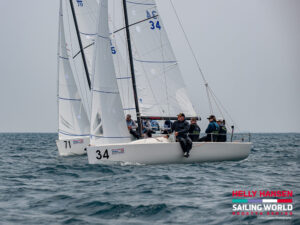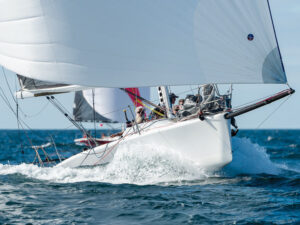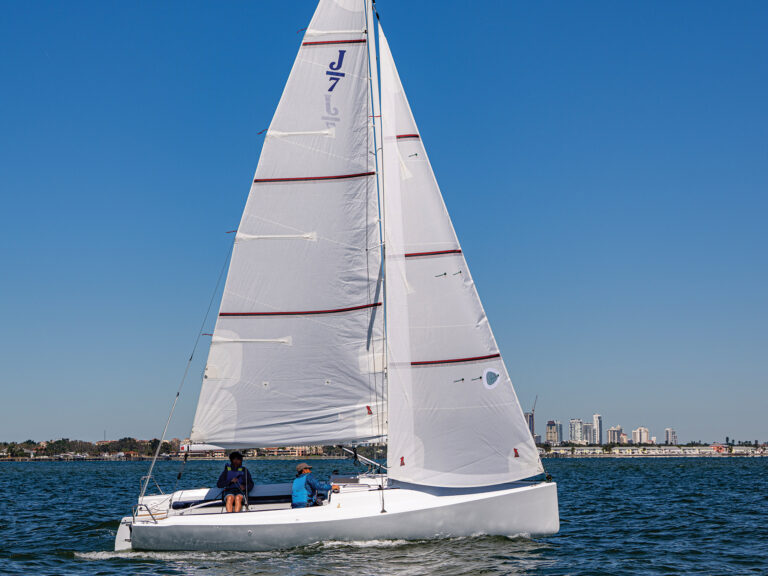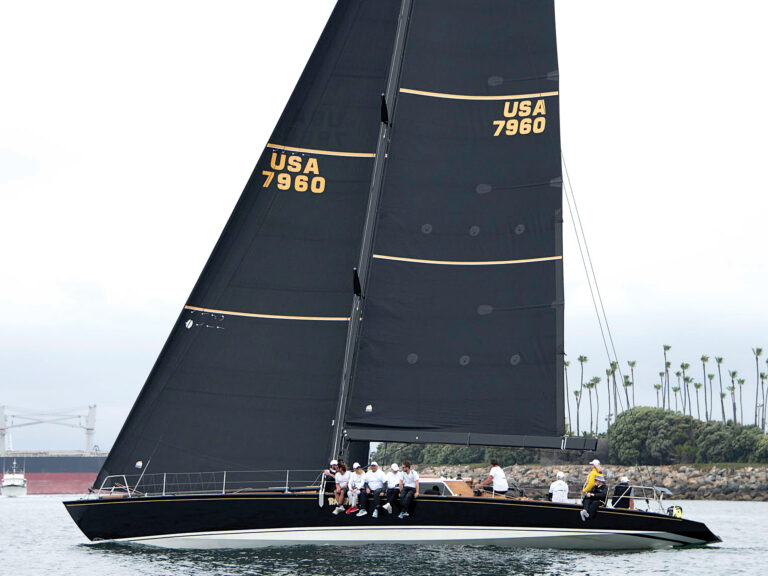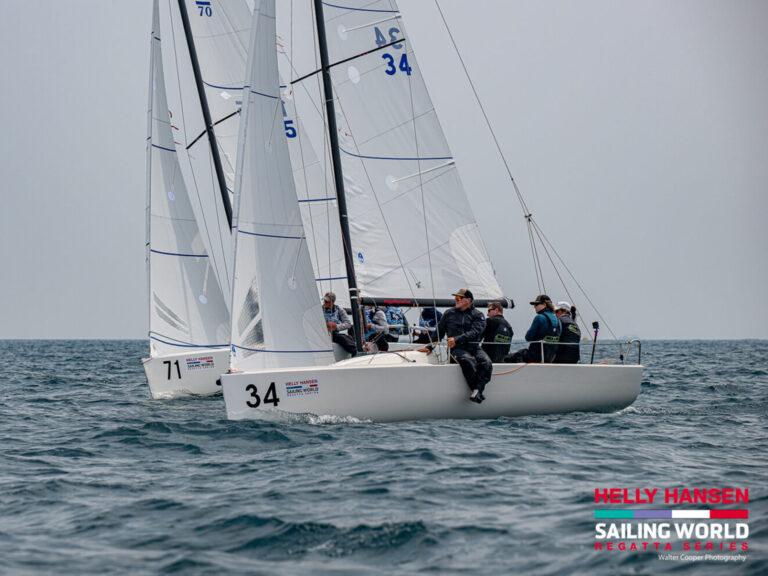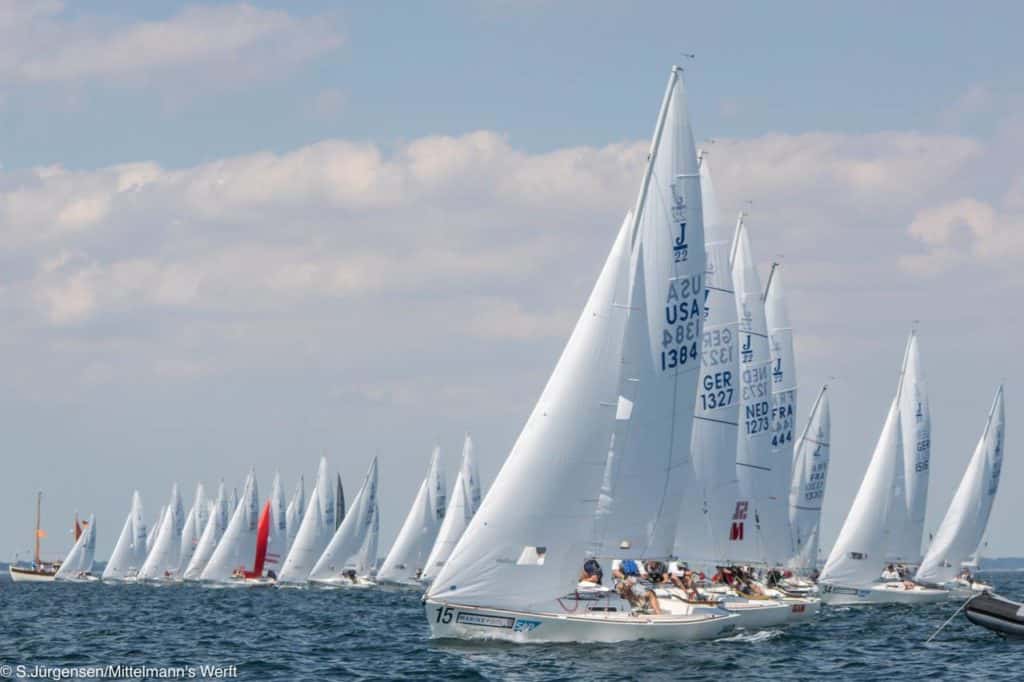
A few years ago I was sailing a J/22 East Coast Championship in a standard, beautiful Chesapeake Bay sea breeze. The waves had built, providing the opportunity for some exciting surfing. We rounded the top mark in decent shape in one race but quickly realized we weren’t holding our own with the boats that rounded close by. We were unable to plane, and the boat was difficult to steer, almost like the bow was full of water. After a frustrating first half of the leg, my best buddy planed over the top of us and pointed at our bow. I then noticed that his bow person was standing behind the mast while my wife was standing in front of our mast in her normal position. Once Jo Ann stepped behind the mast, just 18-inches aft, the boat came alive, and we felt competitive again.
Although our revelation didn’t exactly bring back the boats and distance we’d lost, it showed us how much one little adjustment can mean to boatspeed and a race finish. This thought occurred to me recently, and I started to make a list of the little things that can really add up. To broaden the scope of this story, I enlisted a few of colleagues at North Sailes One-Design. They had a bunch of great ideas; I picked out the best.
1. Think Big Picture
The best way to improve is to race as many different boats as you can and learn from the masters of those classes. I am constantly amazed at how much knowledge one can bring to and take away from other classes. Secondly, consider a coach. Coaching brings perspective on the priorities of the race, both on and off the water. When you’re only involved in your own racing, it is easy to become consumed with details that ultimately may not be the most important. Coaching forces a broader mindset and the ability to boil down big lessons to concrete, usable items. Thirdly, athleticism is truly what separates good sailors from champions. Looking back on my best regattas, I’ve realized that physical preparation played a significant role. Fitness bolsters confidence and mental focus, it allows you to do more, longer.
2. Quick Pole Height Check
While there are many guides often associated with proper spinnaker pole height for symmetric spinnakers, the most popular and most consistent is to position the pole so the tack and clew are parallel with the deck of the boat. However, for the trimmer, gaining a clear shot of the leeward clew is not always possible because the clew is usually hidden behind the main. A great option instead is the relationship of the spinnaker’s vertical center seam to the mast. When this seam is set parallel to the mast, the spinnaker pole is the ideal height.
3. Smooth Water Off the Transom
We try very hard to sail the boat flat in order to have a neutral helm. Weather helm is the boat’s way of telling you that it’s out of balance. You should see smooth water behind the boat when the boat has no or little helm. Conversely, when you have a lot of weather helm, there will be a large wake coming off of the rudder. In extreme cases, the rudder will stall out and the boat will round up. You want the boat set up so that it’s not so overpowered that it’s on its ear. Instead, set up the sail trim and tuning so the boat sails flat and water just glides off the transom.
4. Make Your Notebook Your Sailing Bible
I mark and measure everything on our boat so we can duplicate settings. It’s very important that from leg to leg or day to day, you can repeat what you did the last time you were fast. You can do this by keeping a notebook, in which you should include all your tuning and sail settings, but also weather conditions (especially if you travel), special tactical considerations, and even logistical information. It will make planning your next event easier and also help you study what you did well and what you should improve upon.
-Allan Terhune
5. Determine Your Speed Wrinkles
It’s often difficult to determine exactly how much mast bend is appropriate for a given mainsail in a particular condition. Your sailmaker’s tuning guide is the best place to start. But in lieu of their suggested numbers, an effective guide is to tune the mast so that there is a hint of overbend wrinkles developing in the lower quarter of the main. Encourage pre-bend in lighter breeze, allow bend in heavier breeze. These diagonal wrinkles (often called “speed wrinkles”), angling from the mast toward the clew, are an indication that the mast bend is just enough that the main’s designed shape has matched the mast bend for that condition.
6. Get It Together Early
A good day on the water starts with some pre-start rituals. For me, that includes waking up on time and eating a medium-sized breakfast. Be one of the first boats to leave the dock, and sail by yourself until you feel dialed, so you’re not wasting your training partner’s time time once you hook up. When you do get with your training partner, spend time on both tacks, and then run back down to the line and talk about what was happening on the racecourse. Then, head upwind, split tacks, and try to determine if one side is favored. Run back down to the line and talk about what was happening one more time. Once you’ve done this, hydrate and prepare to start by sailing parallel to the line. Get a bearing, compare it to a head-to-wind reading, and then compare that to the course axis. Keep taking wind readings and identify a favored end. Start in that third of the line, away from other boats, with your objective in mind. Stay on starboard, and be able to flop right away.
-Charlie Enright (Rhode Island)
7. Watch Those Telltales Stream
Many boats have simple guidelines for jib-sheet trim, such as leech distance from the spreader, the position of the skirt as it lays on the deck, or even how far the clew is from the block. However, the most consistent and precise tool is a telltale or two off the upper leech of the jib. When the sheet is set properly, the telltales will flow straight off the leech. If the jib is either over-trimmed or under trimmed, these telltales will indicate a stall in the flow and will either flip around the backside or the front side of the jib. A spreader window in the luff of the main allows the crew to view the telltale from the windward side while hiking.
-Greg Fisher
8. If You’re Not Planing, You’re Dragging
It doesn’t matter whether you’re sailing a downwind leg in a Melges 24 or a reach leg of a triangle course in a Snipe; planing is king. As soon as you round the windward mark, if it’s windy enough for your boat to plane, it should be your No. 1 priority. Once you get the boat planing, you have to do everything within your power to keep it that way. With your immediate boatspeed increase, your apparent wind will move
9. Start The Run Right
Once it’s determined that bearing off as deep as possible at the top mark is the proper tactical move, good boathandling makes the maneuver much more efficient. Here are some suggestions: 1. Don’t cut the mark rounding too tight. Make sure you make a wide enough rounding so the boat doesn’t slow down due to too sharp a turn. Too often we pinch as we approach the mark and the turn around the mark carries the boat wide on the far side and therefore well high of the rhumb line downwind. 2. Ease the mainsheet and keep the jib trimmed tightly to help the boat bear off with minimal rudder action. 3. Ease the vang before turning down around the weather mark. A well-eased vang will better balance the helm and make it much easier for the boat to bear off without using much turn of the rudder. 4. Raise the board halfway before you actually turn around the mark as this will help balance the helm and minimize drag.


